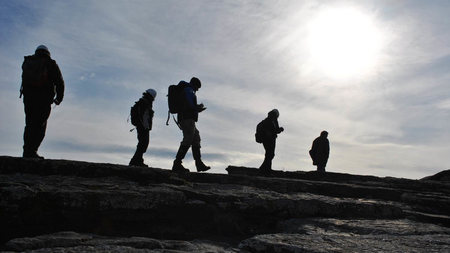
Research PG
- About
-
- Email Address
- d.coathup.20@abdn.ac.uk
- School/Department
- School of Geosciences
Biography
PhD Researcher exploring carbon accumulation, wildfire, and climate changes, in peatland ecosystems globally.
Qualifications
- MEnv Environmental Geography2020 - University of York
External Memberships
Quaternary Research Association
Royal Geographical Society
Past Global Changes (PAGES)
C-PEAT: PAGES Working Group
- Research
-
Research Overview
My research utilises plant macrofossils, testate amoebae, sedimentary charcoal, and Raman spectroscopy, to reconstruct climate, wildfire, and the drivers of carbon accumulation in peatland ecosystems. I currently focus on peat deposits in the boreal and subarctic region, including Finland and Russia, and also the Falkland Islands.
Research Areas

Geography and Environment
Research Specialisms
- Environmental Geoscience
- Environmental Sciences
- Environmental Geography
- Geography
- Physical Geography
Our research specialisms are based on the Higher Education Classification of Subjects (HECoS) which is HESA open data, published under the Creative Commons Attribution 4.0 International licence.
Current Research
1. Holocene Development, Carbon Accumulation, and Fire Regime Characteristics in Boreal Peatlands
This project seeks to improve our understanding of peatland carbon dynamics in response to climate in boreal peatlands of Finland and European Russia. Considering their vast carbon stock, boreal peatlands are still relatively understudied, particularly for detailed multiproxy studies. This is particularly true for European Russia which remains extremely poorly studied and is largely absent from global syntheses on peatland dynamics. Further, peatlands in Finland are an excellent model ecosystem to study carbon dynamics and its relationship to climate changes, as they largely possess an undisturbed development history.
This study will address the knowledge gaps highlighted through a high-resolution, multiproxy, palaeoecological approach that will disentangle the drivers of carbon accumulation across a range of representative mire types for the boreal region. To achieve this, a suite of established (plant macrofossils, testate amoebae, pollen, charcoal) and emerging (Raman spectroscopy) palaeoecological techniques will be applied. Raman spectroscopy has been extensively applied to charcoal material from modern soils, yet has the potential to provide insights on burning intensity during fire events. To date only one study has utilised Raman spectroscopy to reconstruct relative changes in burning intensity from peatlands and therefore this research provides the opportunity to explore a novel analytical technique. The palaeoecological reconstructions will be complimented with robust Bayesian-age modelling chronologies, developed using 210Pb and AMS 14C derived dates.
2. Integrating Raman Spectroscopy and Sedimentary Charcoal to Reconstruct Fire Frequency and Intensity in the Boreal Forest of Southern Finland
This project demonstrates the first attempt to utilise Raman spectroscopy and sedimentary charcoal together to reconstruct variations in Holocene fire frequency and intensity in the boreal forest of southern Finland. Sediments retrieved from a small, peat-accumulating forest hollow are under investigation. The continuous sedimentation process in these ecosystems provides a stratigraphic record of the past from which chronologies can be developed, essential to reconstruct recurrence intervals and place fire regimes in the context of changes in climate. Further, a high moisture content ensures charcoals preserved in the peat layers are more protected from post-deposition combustion, compared with forest soils. These variations in fire regime characteristics will then be placed into the context of the detailed palaeoclimate reconstructions of the wider region. This knowledge will also provide crucial background information for the planning of forest conservation, restoration, and management practices.
3. A novel proxy for energy flux in wildfire: Implications for multi-era climatic change
The aim of the study is to successfully present a novel measure of wildfire energy release, as a proxy for true intensity, through the co-application of cone calorimetry and Raman spectroscopy to charcoal.
4. 'Testing the Waters': Investigating testate amoebae test composition using Raman spectroscopy
This project seeks to develop an efficient and replicable method for Raman spectroscopic identification of common testate amoebae, establishing appropriate acquisitional parameters that ensure sample and spectral integrity. The compositional spectra derived from amoebas will then be utilised to help establish variabilities in chemical composition that may prove indicative of past environmental conditions.
Past Research
Climatic and Autogenic Controls on Peatland Development, Holocene Carbon Accumulation, and Resilience to Degradation in a Southern Pennine Peatland, UK
Master's Dissertation
Peatlands are a critical component of the global carbon cycle and store one-third of the world’s soil organic carbon. Peatland carbon accumulation is governed by the interactions between climate, vegetation, disturbance and fire, yet internal feedback processes produce highly complex responses to forcing. Determining the strength of these variables in controlling long-term carbon accumulation rates is vital to forecast how peatlands will respond to climate change. A multi-proxy palaeoecological investigation into the developmental trajectory and drivers of long-term carbon accumulation was undertaken at Crawshaw Moss, Ilkley Moor. The mire followed the classic succession from lake to Sphagnum-dominated peatland with an accompanying increase in carbon accumulation rates. The peatland showed an inertia to climate variations and a very low intensity of wildfires, reflecting the dominance of autogenic processes and highlights the complexity of forecasting peatlands response to climate change. However, the site has begun to show reduced carbon accumulation and increased wildfire frequency in the face of compounding anthropogenic pressures.
Supervision
Supervisors
Funding and Grants
Quantifying Carbon Accumulation and Loss in Russian Arctic Peatlands
QUADRAT Doctoral Training Partnership | Natural Environment Research Council (NERC)
United Kingdom Research and Innovation (UKRI)
2020 - 2024 | £80,000.00
Quantifying Carbon Accumulation and Loss in European Russian Peatlands
UK - Russia People to People Links Project | British Council
2020 - 2022 | £20,000.00
'Testing the Waters': Investigating Testate Amoebae Test Composition Using Raman Spectroscopy
University of Aberdeen Grants Academy
2023 | £6663.28
A novel proxy for energy flux in wildfire: Implications for multi-era climatic change
University of Aberdeen Grants Academy
2022 - 2023 | £6000.00
